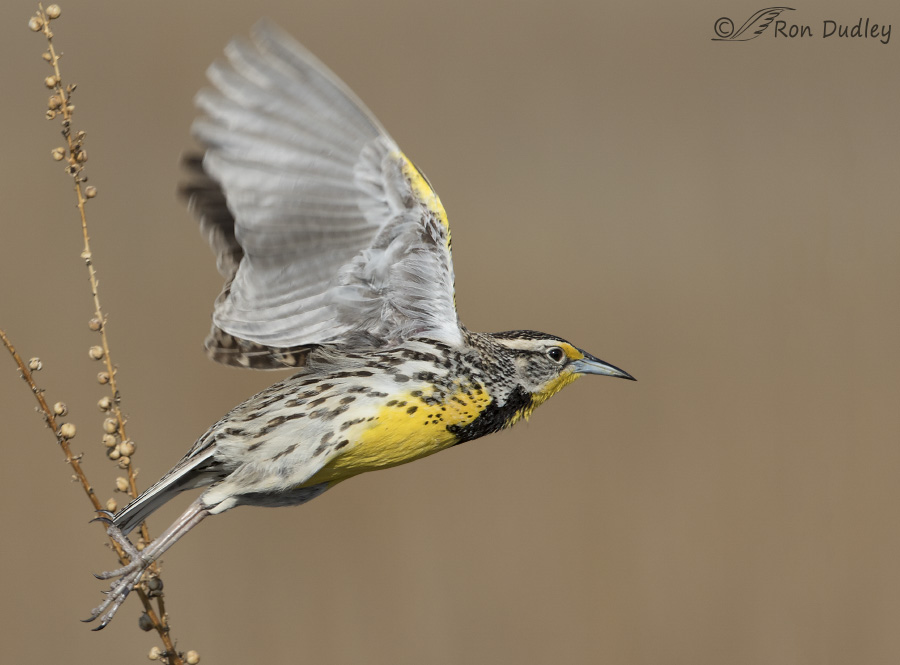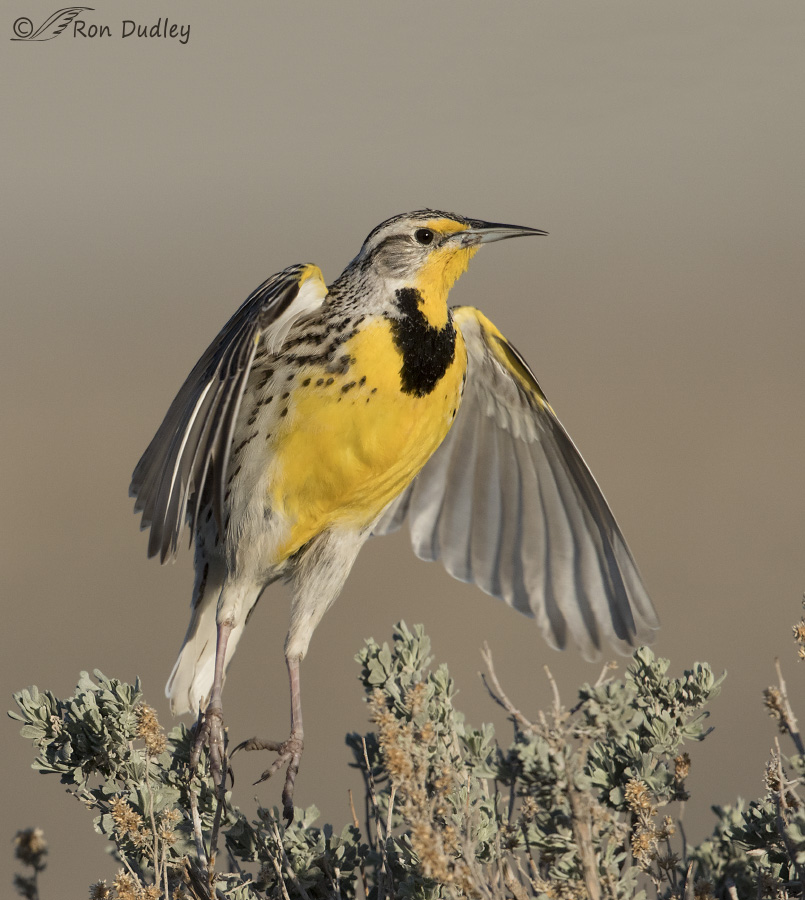Wings of birds move fast at takeoff (and in flight) and the smaller the bird the faster they move. This means that photographers must be cognizant of shutter speed if they want any control over the amount of motion blur in their images.
Wing-tip motion blur is a matter of taste. Some folks have no problem with it because softness of wing-tips implies motion and seems natural given the speed of the wings. Others (like me) prefer to see more crispness and detail in the moving wings. And sharpness isn’t an absolute, instead it’s a matter of degree.
I’ll illustrate with two Western Meadowlark images taken this past summer on Antelope Island.

1/2500, f/7.1, ISO 400, Canon 7D Mark II, Canon EF500mm f/4L IS II USM +1.4 tc, canvas added for composition, not baited, set up or called in
I don’t remember this particular bird but I can tell by my camera settings that my intent was to photograph it perched. Because of their twitchy, jerky movements I typically try for a SS of about 1/2500 sec for small perched birds, knowing it’s not enough to get their wings sharp if they take off. When this bird launched my SS wasn’t nearly fast enough to get the wings sharp. I know that the softness of the wings is due to a relatively slow shutter speed rather than insufficient depth of field because the wings are in roughly the same plane as the body of the bird.
And keep in mind that meadowlarks are several times larger than sparrow-sized birds so I’d have had even more motion blur with a smaller bird.
 1/5000, f/6.3, ISO 800, Canon 7D Mark II, Canon EF500mm f/4L IS II USM +1.4 tc, canvas added for composition, not baited, set up or called in
1/5000, f/6.3, ISO 800, Canon 7D Mark II, Canon EF500mm f/4L IS II USM +1.4 tc, canvas added for composition, not baited, set up or called in
With this bird the only chance I had for a decent shot was at takeoff because while it was perched it was buried in the sagebrush so I had deliberately dialed in a much faster shutter speed. Even at 1/5000 the wings aren’t tack sharp but they’re much sharper than those in the first image. For my tastes this amount of motion blur is perfectly acceptable but I wouldn’t want much more.
The option of using fast shutter speeds is dependent on a number of factors -including available light, speed and quality of the lens and how much digital noise you’re willing to put up with when using higher ISO’s (some cameras are better at handling high ISO’s than others). But for me I’d always rather have a small amount of grain in my images than a soft bird.
I’ve posted about shutter speeds and motion blur before but I believe it to be such an important issue for bird photographers that I thought it was worth another go-round. For those not interested in photo-tech geekiness I hope you at least enjoyed the second image. It’s one that I quite like.
Ron


A great lesson…and a bird I think is overlooked. They are such beauties.
My non-geeky (well my non-photography-geeky self) enjoyed both images.
I think the blurr and its acceptability is dependent on a lot of things. The impression of motion is sometimes more important than the clarity of image – and sometimes not.
There are birds whose plumage is best appreciated when they are in motion, and those images need to be sharp. Sharper than I can ever capture.
For an impression of speed, blur works beautifully.
“For an impression of speed, blur works beautifully.”
That it does, EC. And I enjoyed reading the rest of your thoughts on blur.
This non-geek definitely enjoyed the second image. The bird reminds me of a ballet dancer or ice skater going into a jump.
I’m glad you liked it, Susan. Thank you.
Thanks for the info and the illustrations! I regularly underestimate the shutter speed necessary to prevent unwanted motion blur. Like you, I don’t mind a bit of motion blur–it can add to the action depicted in the shot. Beautiful image as per usual!
“I regularly underestimate the shutter speed necessary to prevent unwanted motion blur”
It’s easy to do, Sharon. Part of the reason I try to err on the other side…
Sometimes I think Meadowlarks make the sun shine….with their song and their color…
I like your theory, Patty.
Sometimes when I’m on the island I deliberately stop my pickup, turn off the engine and get out and just stand there for a while listening to them sing. In some places their song bounces off the hills and mountains and for me it’s just a delicious experience…
How I would love to share that experience…sounds magical…another situation the lakota would call “wakan”….
I wish I could share it with you, Patty.
I think I’ve learned the concept. My problem is the third part of the equation you have mentioned (quality of the lens). There is a big difference between a prime lens opening at f/4 (yours) and a Tamron 150-600mm opening at f/5.6(mine).
Thank you for returning to this essential concept.
“My problem is the third part of the equation you have mentioned (quality of the lens)”
Jorge, yes, that’s an issue and the complete solution isn’t cheap. One can play with some of the other parts of the equation (ISO, aperture) to partially compensate but a fast lens is hard to beat for getting fast shutter speeds.
Ah, meadowlarks! Sweet song, pure beauty and joy!
Agreed, Laura. Antelope Island is loaded with them and I can often hear a dozen or more of them singing at the same time in the early morning.